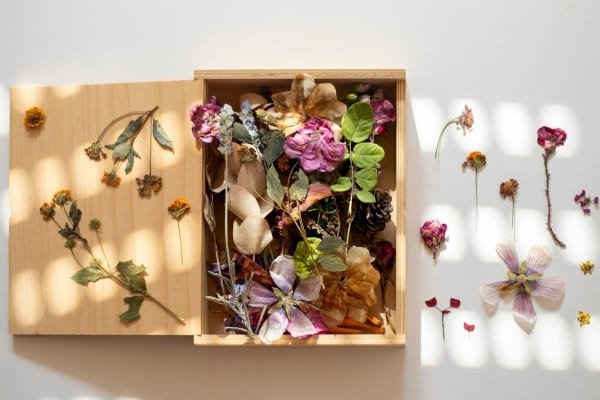Introduction
In an age dominated by digital communication, the charm of a handmade greeting card stands out. Incorporating dried flowers into greeting cards not only adds a touch of natural beauty but also infuses a unique, personal element that can make any card a treasured keepsake. This comprehensive guide will delve into the process of creating dried flower greeting cards, from selecting and preparing the flowers to designing and crafting the cards. We will also explore various themes and occasions for which these cards can be made, along with tips for preserving and maintaining them.
The Appeal of Dried Flower Greeting Cards
Dried flower greeting cards have several appealing qualities:
- Personal Touch: Handmade cards show effort and thoughtfulness, making the recipient feel special.
- Aesthetic Beauty: Dried flowers add an elegant and natural element to cards, enhancing their visual appeal.
- Eco-Friendly: Using dried flowers is a sustainable practice, reducing waste compared to artificial decorations.
- Longevity: Unlike fresh flowers, dried flowers last indefinitely, allowing the recipient to cherish the card for years.
Selecting and Preparing Dried Flowers
Choosing the right dried flowers is the first step in crafting beautiful greeting cards. Consider the following:
1. Types of Flowers
- Flat Flowers: Flowers like pansies, violas, and daisies dry flat and are easy to adhere to cards.
- Small Flowers: Small flowers such as baby’s breath, lavender, and small rosebuds add delicate details.
- Leaves and Ferns: Greenery such as ferns, eucalyptus, and ivy can complement floral elements and add texture.
2. Drying Methods
While you don't need to dry the flowers yourself for this guide, it's useful to understand the common methods:
- Pressing: Pressing flowers between heavy books or in a flower press flattens and preserves them.
- Air Drying: Hanging flowers upside down in a dry, dark place allows them to retain their shape and color.
- Silica Gel: Using silica gel can help preserve the color and shape of more delicate flowers.
Crafting the Greeting Cards
Creating dried flower greeting cards involves several steps, from designing the layout to assembling and preserving the final product.
1. Materials Needed
- Cardstock: Choose high-quality cardstock in various colors and textures as the base for your cards.
- Adhesives: Use clear-drying glue or adhesive tape to attach flowers and other elements.
- Tools: Scissors, tweezers, and a bone folder (for creasing) are essential tools for precision and neatness.
- Decorative Elements: Consider additional elements such as ribbons, stamps, and calligraphy pens for added embellishment.
2. Designing the Layout
Before gluing anything down, plan the layout of your card:
- Theme and Occasion: Decide on the theme based on the occasion, such as birthdays, weddings, or thank-you cards.
- Balance and Composition: Arrange flowers and elements in a balanced manner, considering symmetry and negative space.
- Layering: Experiment with layering flowers and leaves for a three-dimensional effect.
3. Assembling the Card
Once you have a layout you’re happy with, start assembling:
- Adhering Flowers: Use tweezers to handle delicate flowers. Apply a small amount of clear-drying glue to the back of each flower and press gently onto the cardstock.
- Adding Details: Enhance your design with additional decorative elements such as ribbons, stickers, or calligraphy.
- Personal Messages: Include a handwritten or printed message inside the card for a personal touch.
Themes and Occasions
Dried flower greeting cards can be tailored to various themes and occasions. Here are some ideas:
1. Seasonal Cards
- Spring: Use bright, pastel-colored flowers such as daisies and tulips. Add elements like butterflies and bees.
- Summer: Incorporate vibrant flowers like sunflowers and poppies. Use bold colors and beach-themed decorations.
- Autumn: Choose warm-toned flowers like marigolds and chrysanthemums. Add elements like leaves and acorns.
- Winter: Use elegant flowers like poinsettias and snowdrops. Add festive elements like snowflakes and holly.
2. Special Occasions
- Birthdays: Personalize the card with the recipient’s favorite flowers and colors. Add birthday-themed decorations like balloons and candles.
- Weddings: Use romantic flowers such as roses and peonies. Incorporate lace, ribbons, and heart-shaped elements.
- Thank-You Cards: Use simple, elegant flowers such as lavender and baby’s breath. Add elements like gratitude quotes and thank-you stickers.
3. Custom Themes
- Nature-Themed: Use a variety of flowers and greenery to create a lush, garden-like card. Add elements like birds, butterflies, and garden tools.
- Minimalist: Use a single flower or a small bouquet on a plain cardstock. Keep the design simple and elegant.
- Vintage: Use muted colors and antique-style flowers. Add elements like old-fashioned stamps, calligraphy, and sepia tones.
Preserving and Maintaining Dried Flower Cards
To ensure your dried flower greeting cards remain beautiful over time, follow these tips:
1. Protective Coating
- Sealant Spray: Apply a clear, matte sealant spray over the flowers to protect them from moisture and dust.
- Laminating: For added protection, consider laminating the entire card or just the front cover.
2. Storage
- Keep Dry: Store the cards in a dry, cool place away from direct sunlight to prevent fading and moisture damage.
- Protective Sleeves: Place cards in protective sleeves or envelopes to avoid physical damage.
3. Handling
- Gentle Care: Handle the cards with clean, dry hands to avoid transferring oils and dirt onto the flowers.
- Display Options: If displaying the card, consider using a frame or a display case to protect it from the elements.
Advanced Techniques and Creative Ideas
For those looking to take their dried flower greeting cards to the next level, here are some advanced techniques and creative ideas:
1. Mixed Media
Combine dried flowers with other artistic elements:
- Watercolor Backgrounds: Paint a watercolor background before adding dried flowers for a beautiful, blended look.
- Fabric and Textiles: Incorporate pieces of fabric or lace to add texture and depth.
- Embroidery: Embroider designs onto the card and incorporate dried flowers into the stitched elements.
2. Interactive Elements
Make your cards interactive:
- Pop-Up Cards: Create pop-up elements with dried flowers for a surprising 3D effect.
- Pull Tabs: Add pull tabs that reveal hidden messages or additional floral elements.
3. Themed Collections
Create a series of cards based on a specific theme or collection:
- Botanical Series: Create a set of cards featuring different types of flowers and plants.
- Color-Themed Sets: Make a series of cards each focusing on a specific color palette.
- Holiday Collections: Design cards for various holidays, incorporating relevant floral elements and decorations.
Conclusion
Dried flower greeting cards are a beautiful and meaningful way to show someone you care. By selecting the right flowers, planning your design, and carefully assembling the elements, you can create stunning, personalized cards for any occasion. Whether you’re a seasoned crafter or a beginner, the process of making these cards can be both enjoyable and rewarding. With the tips and techniques outlined in this guide, you’ll be well on your way to creating dried flower greeting cards that are sure to impress and delight your recipients.
Remember, the key to a beautiful dried flower greeting card is in the details and the personal touches you add. Happy crafting!




